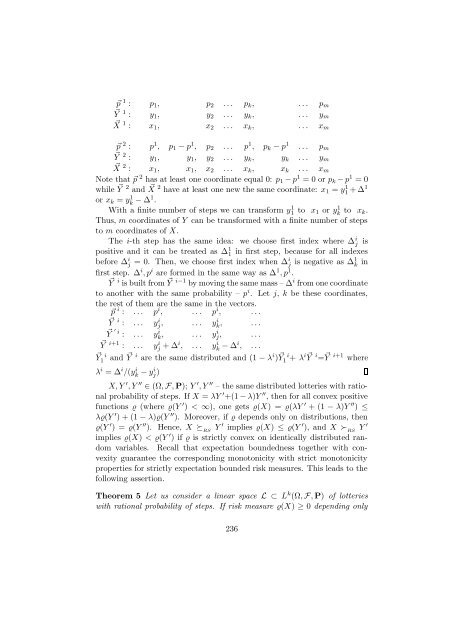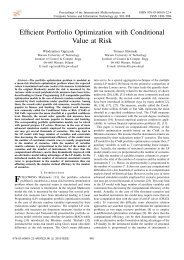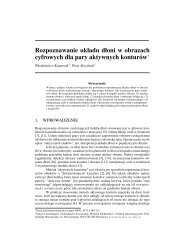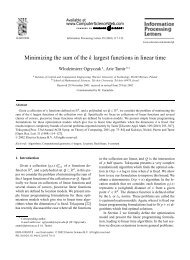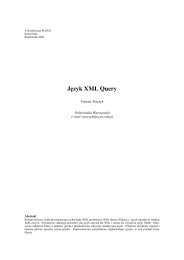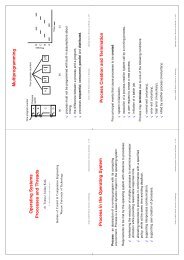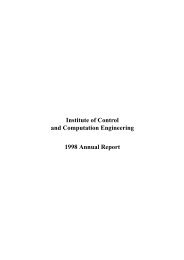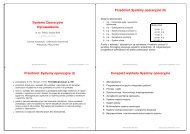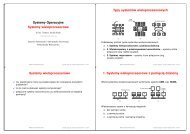SSD CONSISTENT CRITERIA AND COHERENT RISK MEASURES
SSD CONSISTENT CRITERIA AND COHERENT RISK MEASURES
SSD CONSISTENT CRITERIA AND COHERENT RISK MEASURES
You also want an ePaper? Increase the reach of your titles
YUMPU automatically turns print PDFs into web optimized ePapers that Google loves.
⃗p 1 : p 1 , p 2 . . . p k , . . . p m<br />
⃗Y 1 : y 1 , y 2 . . . y k , . . . y m<br />
⃗X 1 : x 1 , x 2 . . . x k , . . . x m<br />
⃗p 2 : p 1 , p 1 − p 1 , p 2 . . . p 1 , p k − p 1 . . . p m<br />
⃗Y 2 : y 1 , y 1 , y 2 . . . y k , y k . . . y m<br />
⃗X 2 : x 1 , x 1 , x 2 . . . x k , x k . . . x m<br />
Note that ⃗p 2 has at least one coordinate equal 0: p 1 − p 1 = 0 or p k − p 1 = 0<br />
while Y ⃗ 2 and X ⃗ 2 have at least one new the same coordinate: x 1 = y1 1 + ∆1<br />
or x k = yk 1 − ∆1 .<br />
With a finite number of steps we can transform y1 1 to x 1 or yk 1 to x k.<br />
Thus, m coordinates of Y can be transformed with a finite number of steps<br />
to m coordinates of X.<br />
The i-th step has the same idea: we choose first index where ∆ i j is<br />
positive and it can be treated as ∆ 1 1 in first step, because for all indexes<br />
before ∆ i j = 0. Then, we choose first index when ∆i j is negative as ∆1 k in<br />
first step. ∆ i , p i are formed in the same way as ∆ 1 , p 1 .<br />
⃗Y i is built from Y ⃗ i−1 by moving the same mass – ∆ i from one coordinate<br />
to another with the same probability – p i . Let j, k be these coordinates,<br />
the rest of them are the same in the vectors.<br />
⃗p i : . . . p i , . . . p i , . . .<br />
⃗Y i : . . . yj i, . . . yi k , . . .<br />
⃗Y ′ i : . . . yk i , . . . yi j , . . .<br />
⃗Y i+1 : . . . yj i + ∆i , . . . yk i − ∆i , . . .<br />
⃗Y 1 i and Y ⃗ i are the same distributed and (1 − λ i ) Y ⃗ 1 i+<br />
Y ⃗ i = Y ⃗ i+1 where<br />
λ i = ∆ i /(y i k − yi j )<br />
X, Y ′ , Y ′′ ∈ (Ω, F, P); Y ′ , Y ′′ – the same distributed lotteries with rational<br />
probability of steps. If X = λY ′ +(1 − λ)Y ′′ , then for all convex positive<br />
functions ϱ (where ϱ(Y ′ ) < ∞), one gets ϱ(X) = ϱ(λY ′ + (1 − λ)Y ′′ ) ≤<br />
λϱ(Y ′ ) + (1 − λ)ϱ(Y ′′ ). Moreover, if ϱ depends only on distributions, then<br />
ϱ(Y ′ ) = ϱ(Y ′′ ). Hence, X ≽ RS<br />
Y ′ implies ϱ(X) ≤ ϱ(Y ′ ), and X ≻ RS<br />
Y ′<br />
implies ϱ(X) < ϱ(Y ′ ) if ϱ is strictly convex on identically distributed random<br />
variables. Recall that expectation boundedness together with convexity<br />
guarantee the corresponding monotonicity with strict monotonicity<br />
properties for strictly expectation bounded risk measures. This leads to the<br />
following assertion.<br />
Theorem 5 Let us consider a linear space L ⊂ L k (Ω, F, P) of lotteries<br />
with rational probability of steps. If risk measure ϱ(X) ≥ 0 depending only<br />
236


